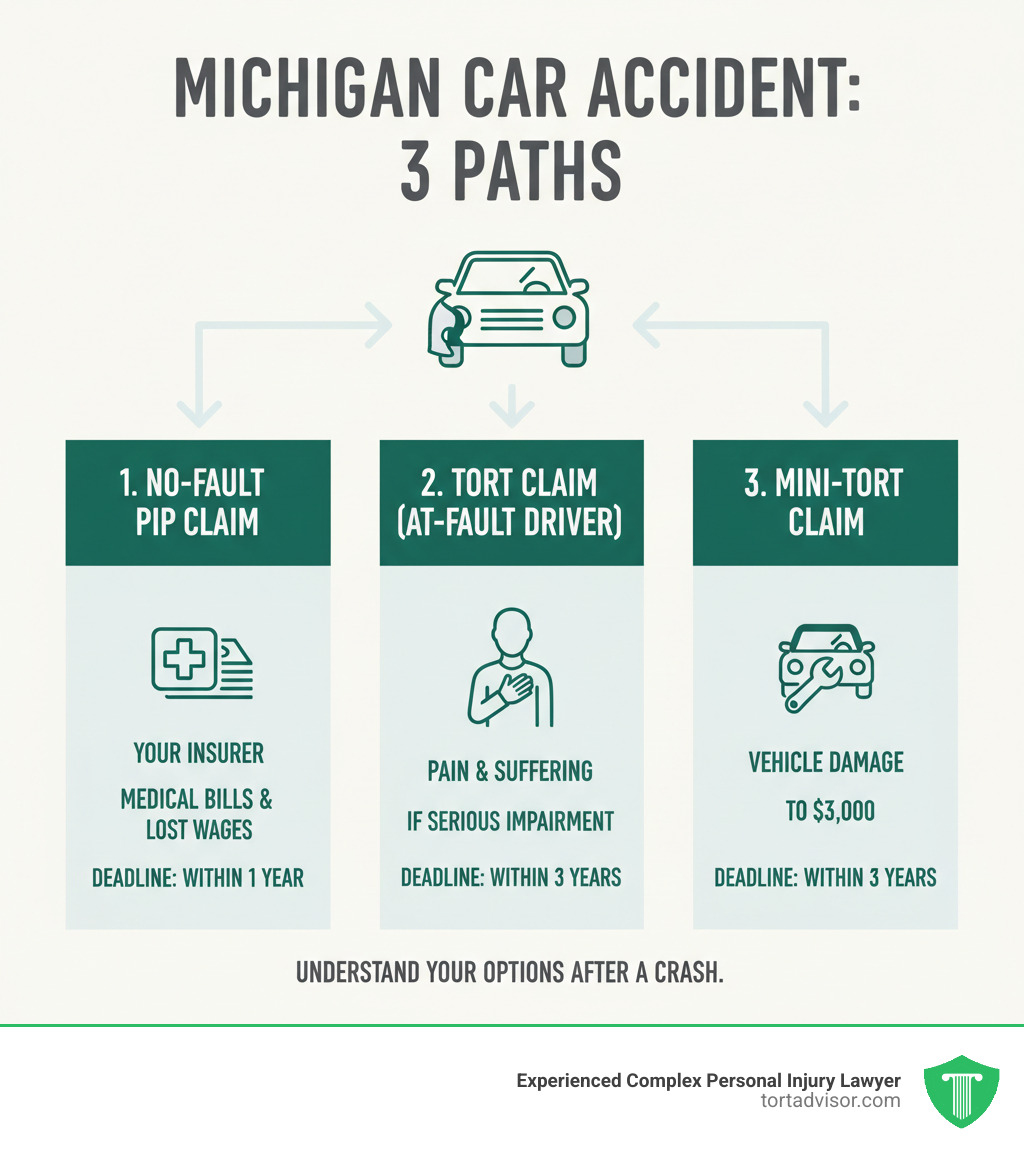


Understanding Michigan’s Unique Approach to Car Accident Claims
How does a car accident lawsuit work michigan is a question with a more complex answer than in most states because Michigan operates under a unique dual system. Here’s what you need to know:
Michigan Car Accident Lawsuit Process – Quick Overview:
- No-Fault Insurance First – Your own insurance covers medical bills and lost wages, regardless of who caused the accident.
- Three Potential Lawsuits – You can file up to three different types of claims:
- First-Party Claim: Sue your own insurer for unpaid No-Fault benefits (1-year deadline).
- Third-Party Tort Claim: Sue the at-fault driver for pain/suffering and excess damages (3-year deadline).
- Mini-Tort Claim: Sue for vehicle damage up to $3,000 (3-year deadline).
- Serious Injury Threshold – To sue for pain and suffering, you must prove a “serious impairment of body function.”
- Modified Comparative Fault – If you’re more than 50% at fault, you can’t recover non-economic damages.
- Typical Timeline – Most cases take 12-24 months from filing to resolution.
The process involves hiring an attorney, filing a complaint, gathering evidence (findy), negotiating a settlement, and potentially going to trial.
Navigating Michigan’s complicated legal system after a car accident is stressful. The state’s no-fault system means you first deal with your own insurer for basic benefits. However, if your injuries are serious or benefits are denied, a lawsuit may be necessary. Unlike in most states, Michigan law requires understanding when you can sue the at-fault driver, what legal thresholds you must meet, and which insurance company you’re actually fighting.
First Steps and Understanding Michigan’s Unique Insurance System
After a car accident in Michigan, your immediate actions can significantly impact your health and any potential claim.
Initial Steps After a Car Accident in Michigan
- Check for Injuries and Call 911: If anyone is hurt or there’s serious vehicle damage, call 911 immediately.
- Secure the Scene: If safe, move vehicles out of traffic and turn on hazard lights.
- Document Everything: Use your phone to take photos of vehicle damage, the accident scene, skid marks, traffic signs, and any visible injuries.
- Exchange Information: Swap names, phone numbers, insurance details, and license plate numbers with the other driver. Avoid admitting fault or arguing.
- Identify Witnesses: Get names and contact information from any witnesses.
- Report to Police: Michigan law requires reporting accidents with injury, death, or property damage over $1,000. A police report provides an objective record.
- See a Doctor: Get a medical evaluation within a day or two, even if you feel fine. Adrenaline can mask injuries like whiplash or concussions, and this creates a medical record linking your injuries to the crash.
- Notify Your Insurer: Promptly inform your insurance company to start the claims process.
How Michigan’s No-Fault Insurance System Affects a Car Accident Lawsuit
Michigan’s no-fault insurance system is unique. After an accident, your own car insurance company pays for your medical expenses and lost wages, regardless of who was at fault. This is called Personal Injury Protection (PIP).
PIP coverage includes:
- Reasonably necessary medical expenses: Doctor visits, surgery, physical therapy, etc.
- Up to 85% of lost wages for up to three years if you cannot work.
- Replacement services like housekeeping or childcare if your injuries prevent you from performing these tasks.
The no-fault system doesn’t eliminate lawsuits. If you suffer a serious injury, you can step outside the system and sue the at-fault driver for pain and suffering.
What is the ‘Mini Tort’ Law?
The mini tort law addresses damage to your vehicle. It allows you to recover up to $3,000 for vehicle damage from the at-fault driver’s insurance, provided they were at least 50% responsible. This can cover your collision deductible or other repair costs. If the claim is denied, you can sue in Small Claims Court. You have a three-year deadline to file a mini tort lawsuit from the accident date.
The Two Main Types of Michigan Car Accident Lawsuits
Michigan’s no-fault system creates two distinct legal paths for car accident victims: first-party and third-party claims. Understanding which applies to you is critical.
First-Party Lawsuit: Suing Your Own Insurance Company
A first-party lawsuit is filed against your own auto insurer when they deny, delay, or cut off your No-Fault benefits. Your insurer is contractually obligated to pay for your medical bills, lost wages, and replacement services, regardless of fault. When they fail to do so, you can sue them.
These benefits cover all reasonably necessary medical expenses, up to 85% of your lost income for three years, and replacement services for tasks you can no longer perform.
Insurers may deny claims by arguing your injuries are unrelated to the accident or that treatment isn’t “reasonable.” This is why legal representation is often necessary.
Critical Deadlines: You must file an application for No-Fault benefits within one year of the accident. To sue for unpaid benefits, you have one year from the date each specific expense was incurred. Missing these deadlines can result in a permanent loss of benefits.
Third-Party Lawsuit: Suing the At-Fault Driver
A third-party lawsuit is the more traditional claim against the driver who caused the crash. This type of suit seeks compensation beyond what your no-fault insurance provides.
You can pursue two main types of damages:
- Pain and Suffering (Noneconomic Damages): Compensation for physical pain, emotional distress, and loss of enjoyment of life.
- Excess Economic Losses: Medical bills and lost wages that exceed your No-Fault PIP coverage limits.
However, Michigan law requires you to prove you’ve suffered a “serious impairment of body function” to sue for pain and suffering. This high threshold prevents minor injury claims from flooding the courts.
You have three years from the date of the accident to file a third-party lawsuit. While longer than the first-party deadline, it’s wise to act quickly while evidence is fresh and witness memories are clear.
How Does a Car Accident Lawsuit Work in Michigan? The Step-by-Step Process
A Michigan car accident lawsuit follows a structured process. Most cases take 12 to 24 months to resolve, but the timeline depends on factors like injury severity, case complexity, and the court’s schedule. An experienced attorney can guide you through each stage.
Step 1: Hiring an Attorney and Filing the Complaint
The first step is to hire a qualified attorney. Most work on a contingency fee basis, meaning you pay nothing unless you win. Your attorney will investigate your case, gather evidence, and then file a complaint with the court. This legal document outlines what happened, who is responsible, and the compensation you seek. A summons is then served to the defendant, who typically has 21-28 days to file an answer.
Step 2: The Findy Phase in a Michigan Car Accident Lawsuit
This stage, known as findy, is where both sides gather evidence. It can last six to twelve months and involves several tools:
- Interrogatories: Written questions sent to the opposing party, which must be answered under oath.
- Requests for Production of Documents: Formal requests for relevant paperwork like insurance policies, medical records, and cell phone records.
- Depositions: Out-of-court testimony where attorneys question witnesses and parties under oath.
- Independent Medical Examinations (IMEs): The defense may require you to be examined by a doctor they hire to get an opinion on your injuries.
Step 3: Settlement Negotiations and Mediation
The vast majority of car accident lawsuits settle before trial. Negotiations can begin once enough evidence has been gathered. Your attorney will send a demand letter to the insurance company, detailing your injuries, expenses, and a specific settlement amount. The insurer will respond with a counter-offer, and negotiations will proceed.
If direct talks stall, mediation may be used. A neutral third-party mediator helps both sides find common ground and reach a voluntary agreement. Settlement provides a certain outcome and avoids the risks of a trial.
Step 4: What Happens if Your Michigan Car Accident Lawsuit Goes to Trial?
If a fair settlement cannot be reached, the case proceeds to trial. The process includes:
- Jury Selection: Attorneys question potential jurors to select an impartial panel.
- Opening Statements: Each side presents a roadmap of their case to the jury.
- Presenting Evidence: Attorneys call witnesses (including you, medical experts, etc.) and present documents to support their claims. Each side can cross-examine the other’s witnesses.
- Closing Arguments: Attorneys summarize the evidence and argue why the jury should rule in their favor.
- Jury Deliberation and Verdict: The jury discusses the case in private and reaches a decision on liability and damages.
Compensation and Key Legal Problems in Michigan
Understanding what compensation you can recover is key to knowing how does a car accident lawsuit work in Michigan. Damages are divided into two categories.
Types of Compensation You Can Seek
Economic damages are your calculable financial losses, including:
- Past and future medical expenses
- Lost wages and lost earning capacity
- Vehicle damage (up to $3,000 via mini tort, or full cost in a third-party suit)
- Other out-of-pocket expenses
Noneconomic damages compensate for non-financial losses that don’t have a price tag. Noneconomic damages in Michigan include:
- Pain and suffering
- Loss of enjoyment of life
- Permanent scarring or disfigurement
- Loss of consortium (for a spouse)
The ‘Serious Impairment of Body Function’ Threshold
In Michigan, you cannot sue for noneconomic damages (pain and suffering) unless you meet a high legal bar. According to the legal standard for pain and suffering claims, you must prove a “serious impairment of body function, permanent serious disfigurement, or wrongful death.”
To prove a “serious impairment,” you must show:
- An objectively manifested impairment that a doctor can observe or measure (e.g., a broken bone on an X-ray).
- The impairment affects an important body function (e.g., walking, thinking).
- The impairment affects your general ability to lead your normal life.
Soft tissue injuries like whiplash often struggle to meet this threshold unless they cause severe, long-term functional limits. Thorough medical documentation is critical.
How Comparative Negligence Affects Your Claim
Michigan uses a modified comparative fault system. Under Michigan’s comparative negligence law, a jury assigns a percentage of fault to each party. Your total compensation is reduced by your percentage of fault.
For example, if you are awarded $100,000 but found 20% at fault, you receive $80,000.
Critically, Michigan has a “50% fault bar” for noneconomic damages. If you are found more than 50% at fault (51% or more), you are completely barred from recovering any money for pain and suffering. You can still recover a reduced portion of your economic damages, but the noneconomic damages are lost entirely.
Frequently Asked Questions about Michigan Car Accident Lawsuits
How long do I have to file a car accident lawsuit in Michigan?
Michigan’s filing deadlines, or statutes of limitations, are strict and vary by claim type:
- Third-Party Injury/Tort Claims: You have three years from the accident date to sue the at-fault driver for pain and suffering. This also applies to the three-year deadline to file a mini tort lawsuit for vehicle damage.
- First-Party No-Fault Claims: You must file an application for No-Fault benefits with your insurer within one year of the accident. To sue for unpaid benefits, you have one year from the date each specific service was incurred.
- Wrongful Death Claims: The estate’s personal representative generally has three years from the date of death to file a lawsuit.
Missing these deadlines can permanently bar your claim.
What is the typical timeline for a car accident lawsuit in Michigan?
While every case is different, a typical Michigan car accident lawsuit takes 12 to 24 months to resolve. Simple cases may settle in a few months, while complex cases involving severe injuries or disputed liability can take over two years. Factors influencing the timeline include injury severity, case complexity, court schedules, and the willingness of the parties to negotiate.
Will I have to go to court for my car accident case?
Probably not. The vast majority of car accident cases settle before trial through negotiation or mediation. Insurance companies often prefer to settle rather than face the uncertainty and expense of a jury trial.
However, preparing a case as if it will go to trial is the best strategy. It shows the insurance company you are serious and often leads to a better settlement offer. If a fair settlement isn’t possible, your attorney will be prepared to represent you in court.
Conclusion
Understanding how does a car accident lawsuit work michigan is challenging due to the state’s unique dual system of no-fault and tort law. You must steer first-party claims with your own insurer for PIP benefits and potential third-party claims against the at-fault driver for pain and suffering.
Key problems include strict deadlines (one year for No-Fault applications, three years for tort claims), the “serious impairment of body function” threshold for pain and suffering damages, and the modified comparative fault rule that can eliminate your noneconomic damages if you are more than 50% at fault.
The legal process is complex, and insurance companies have teams dedicated to minimizing payouts. Going it alone is a significant disadvantage.
That’s where Tort Advisor comes in. We connect clients with top-rated specialty attorneys who have proven track records in Michigan car accident cases. Our role is to match you with legal counsel who will fight for the compensation you deserve, whether through a fair settlement or a trial.
You’ve been through enough. Let us connect you with an expert who can steer Michigan’s complicated legal system for you. A consultation is free, and you pay nothing unless your attorney wins your case. There’s no risk in reaching out for the help you need.
Free Confidential Case Evaluation
Complete the short form below to get an immediate FREE case review with an expert in your specific claim. Don't wait, your case could be time sensitive to file a claim.
Related Posts
Did a North Dakota product cause harm? Understand product liability, your rights, and how to take action for defects.
Get justice for clergy abuse. Find an expert Priest abuse lawyer to navigate complex laws and hold institutions accountable.
Diagnosed with meningioma after Depo-Provera? Understand potential Depo-Provera lawsuit settlements, risks, & how to claim compensation.
Uncover the truth about uber sexual assault cases. Learn about the alarming scale, Uber's accountability, and legal options for justice.
Facing wildfire losses? Discover the best wildfire lawsuit attorneys in California to fight for your full recovery and justice.
Exposed to Roundup & diagnosed with NHL? Discover how to sue Monsanto, understand eligibility, & seek compensation. Your guide to justice.









